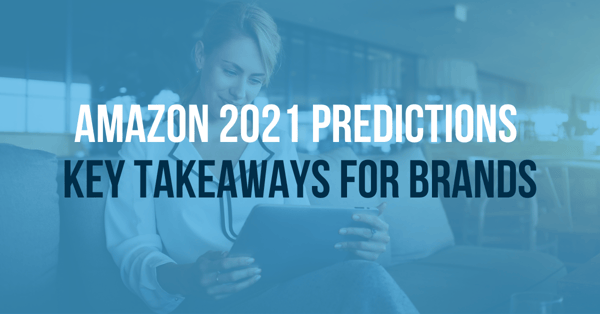Are you confident about your brand’s Amazon strategy for 2021? A lack of understanding about trends that are dominating the marketplace will severely impede your growth plans.
In a recent post on Forbes, Bobsled CEO Kiri Masters laid out six major predictions for Amazon this year.
We’ve taken these macro predictions and boiled them down into actionable takeaways for brands selling on the channel. Enjoy!

1) Amazon's Fulfillment capabilities will become their next AWS
Amazon performed so strongly in 2020 due to their wildly impressive logistics infrastructure. Kiri believes there’s an opportunity for Amazon to use their Multi-Channel Fulfillment option as inspiration, and further white-label their fulfillment capabilities, just like they have done with AWS.
“Amazon could become a vendor of warehouse management solutions, a shipping carrier that any individual or company can use to send packages, and a preferred 3PL for direct-to-consumer brands,” she writes on Forbes.
If Amazon moves in this direction, it will likely mean more investment into solving the riddle of last-mile delivery. There would also be significant changes to the Seller-Fulfilled Prime (SFP) program, as Amazon strangles competitors and improves the reliability of their shipping solutions. According to Kiri, “SFP users could be required to use Amazon shipping only, and SFP users actually become micro-fulfillment hubs for Amazon.”
✔️ Takeaway for brands: If Amazon uses their size and deep pockets to offer an even more comprehensive retail fulfillment solutions at an affordable price, many brands will have no choice but to sign up.
This will change the composition of in-house teams (e.g. certain fulfillment positions becoming surplus to requirements, hiring new staff who intimately understand how Amazon’s fulfillment systems work from a strategic perspective). It may also make brands rethink investing large sums into their own logistics infrastructure. In other words, if it’s more efficient and affordable to use Amazon fulfillment for everything, why would a brand invest any extra money in their own equipment or storage? Of course certain brands will always want to keep everything in-house for a variety of reasons, but many will be swayed as Amazon’s fulfillment capabilities become even more compelling.
💡 Check out Delayed Inbound FBA Shipment – Troubleshooting Guide
2) More experiments with live video and virtual experiences
There are several new programs (Posts, Live and Experiences) that are all designed to encourage brands to share more interactive content on Amazon.
“We can see from the Chinese market where livestreaming is likely to go in the US,” writes Kiri on Forbes. “In 2019, livestream shopping accounted for 9% of China’s total ecommerce revenues.”

✔️ Takeaway for brands: In addition to a marketplace, Amazon needs to be thought of as a stand-alone social media platform. Brands need to define their content strategy, then train or hire staff. Many should also seriously consider partnering with influencers who can help shorten the learning curve.
💡 Check out Working With Influencers For Amazon Live
3) Amazon will slow down or even stop its private label brand expansion
Kiri believes Amazon will pump the brakes on their private label efforts for two main reasons.
Firstly, the recent antitrust investigations identified the in-house private label products as examples of Amazon acting unethically, thus creating a PR headache. Secondly, so far the private label brands haven’t performed that well. “I also doubt that these products surely can’t be more profitable than selling advertising to brands that they compete with,” writes Kiri on Forbes.
✔️ Takeaway for brands: If you have been wanting to expand your catalog with new items, but are afraid that Amazon will compete directly with private label competitor products, it could be the right time to pull the trigger. But be warned – this is one area where taking a wait-and-see approach is definitely the right move, as it’s impossible to know in which direction Amazon will pivot.
However, brands should be capitalizing on the poor PR about Amazon’s in-house products, and doing everything to differentiate themselves. Improving product listing content and top-of-funnel advertising on DSP are great ways to educate Amazon customers about the uniqueness and quality of your product catalog.
💡 Check out Amazon DSP Retargeting - The First 30 Days
4) More competition amongst sellers
Kiri claims the fact that successful smaller brands on Amazon are being snapped up in record volumes by large holding companies, and the consistently huge numbers of Chinese sellers on the market, as evidence that the Amazon marketplace is only destined to become more competitive in 2021.
✔️ Takeaway for brands: Recognize your desired place in the crowded market vs direct competitors, or run the risk of being left out in the cold. Understand your target audience, and carefully analyze existing performance. Decide which products are right for Amazon vs other channels. Once you’re clear on your positioning, refine your SEO and paid strategy accordingly.
💡 Check out Amazon SEO Strategy - Bobsled's Crash Course
5) Bulking up Amazon Fresh
Amazon took a slight hit in the online grocery space in 2020, with Walmart and Instacart making big strides. But Amazon is well placed to pivot and go after more online grocery shoppers. Kiri is anticipating a lot more grocery expansion and integration from Amazon in 2021.
“A crucial ingredient (pardon the pun) that Amazon is missing right now is seamless integration of its various shopping platforms. The consumer experience is disrupted when trying to shop across Amazon.com, Amazon Fresh, and Prime Now. In the future – my guess is 2021 – these platforms will be consolidated to eliminate the current confusion that shoppers experience when trying to build a basket,” she writes on Forbes.
✔️ Takeaway for brands: Make it easy for shoppers to find your grocery products on Amazon (check out Bobsled’s Amazon Fresh Guide for more info). Also, be sure to explore Instacart and Walmart – understand which channels are right for your brand. Instacart is particularly important because it directly impacts non-grocery brands too.
💡 Check out Instacart for CMOs – Book Overview

6) Amazon Advertising will accelerate
More competition on Amazon means that the battle for ranking high on the search results page is destined to become more dog eat dog. Fortunately, Amazon is always developing new advertising tools, helping savvy brands get an edge over competitors.
Kiri is adamant that Amazon will provide more top-of-funnel awareness levers in 2021.
“Amazon added new features to its Sponsored Display ad type in 2020 that are more similar in nature to traditional media spend (impression tracking, interest targeting) than to pay-per-click performance advertising. This opens up many new opportunities for both established and startup brands to target Amazon shoppers at ever-earlier stages of the purchase journey.”
✔️ Takeaway for brands: Every brand is in a unique situation in terms of the best way to use paid tools on Amazon. But in the interest of simplifying a complex topic – to profitably grow your market share on Amazon you need the right ad technology, and the right team overseeing the paid ad strategy.
💡 Check out Marketplace Ad Tech: How Does It Work?
Tagged: PPC Advertising, Amazon Account Management, Amazon Updates
.png)

